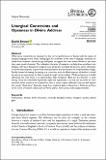Liturgical constraints and openness in divine address
Abstract
While some constraints are necessary to the correct performance of liturgy, both the nature of liturgical language and its wider setting argue for openness. In the case of language, examples are drawn from scripture, formal liturgy and hymns to suggest that their power derives in part from their open, poetic character. The multivalent character of metaphor can help draw worshipers into dialogue with God. Because all metaphors are partial and inevitably fail at some point, elimination is not the best response to perceived inadequacies but the introduction of complementary images. Equally, instead of viewing the setting as a constraint, as in the Hindu concept of darshan it should be seen as an opportunity for God to speak through human artefact. While architecture is briefly addressed, the main focus is on stained glass. Pope Gregory’s “Bible for the illiterate” is quite wrong. Once the rules behind particular styles are appreciated, not only can its power to communicate divine presence be activated but also at times original reflections that go well beyond the merely “illustrative.” Examples range from medieval glass at Canterbury, Chartres and Sens to the work of modern artists such as Harry Clarke, Tom Denny, and Douglas Strachan.
Citation
Brown , D 2022 , ' Liturgical constraints and openness in divine address ' , Studia Liturgica , vol. OnlineFirst . https://doi.org/10.1177/00393207211049272
Publication
Studia Liturgica
Status
Peer reviewed
ISSN
0039-3207Type
Journal article
Collections
Items in the St Andrews Research Repository are protected by copyright, with all rights reserved, unless otherwise indicated.

